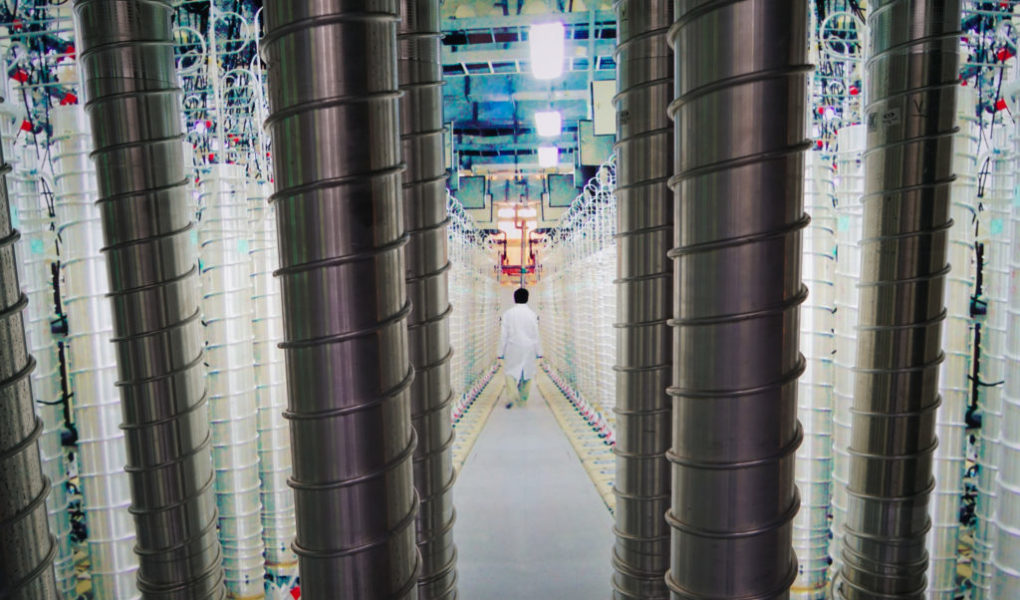A central element of the new film Oppenheimer is time. The time needed to design and construct the ultimate weapon is marked through the steady accumulation of marbles in a fishbowl and a wine glass, which represent the growing stockpiles of uranium and plutonium that ultimately fueled the devices dropped seventy-eight years ago on Hiroshima and Nagasaki.
Time is also a crucial policy consideration in dealing with another country nearing the Oppenheimer finish line: Iran. Its “fishbowl” overflows with enough uranium to yield, with further enrichment, fissile material for multiple nuclear weapons in short order. US policy assumes that even if Iran fills that fishbowl, enriching uranium to weapons grade, there would still be ample time to prevent it from attaining nuclear weapons. Yet, as Oppenheimer and the history of the US nuclear program illustrate, those assumptions do not hold.
Every president since at least George W. Bush has pledged to prevent Iran from getting a nuclear weapon.Yet Chairman of the Joint Chiefs of Staff General Mark Milley explicitly qualified this commitment. In March 2023, he told Congress that his concern was an Iranian “fielded nuclear weapon.” This suggests that if Iran produces fissile material, designs a nuclear weapon, develops a long-range ballistic missile to deliver it, and perhaps even combines all three of these elements it would still not run afoul of US pledges.
US policy seems to be predicated on the assumption that Iran’s path to nuclear weapons will be sequential. Thus, even as Tehran has been filling its fishbowl with multiple bombs’ worth of 20 and 60 percent enriched uranium, officials in Washington (and Jerusalem) remained sanguine in their estimate that Iran still needs roughly two years or more for “weaponization” – a process it would only begin after it breaks out by enriching 90 percent uranium. The United States assumes that Iran would not be “nuclear” until it designed, built, assembled, and possibly tested a working nuclear device adapted to fit and survive reentry in a missile warhead. Furthermore, the United States assumes it would have a sufficient capacity at each of those steps to detect and stop the Iranian program.
These assumptions are flawed, based on what is known about producing nuclear weapons from the history of the US atomic project, and what is unknown about Iran’s program.
The path to a weapon need not be sequential. As Oppenheimer shows, the Manhattan Project could meet its tight, and hastily condensed, deadlines by advancing on weapons designs and fissile material simultaneously. Enrichment of uranium for the “Little Boy” bomb dropped on Hiroshima began at Oak Ridge in March 1944 while the weapon’s design started just four months later at Los Alamos Laboratory.
Iran, too, has not waited to finish enrichment before beginning weaponization. It already had a nuclear weapons program at the turn of the millennium, around the time it began accumulating marbles in the fishbowl. Although US intelligence assessed the weaponization program to have been shut down in 2003, the nuclear archives seized by Israel from Tehran in 2018 show that it merely went underground, and that ongoing progress since then gives it a running start toward any final dash to finish a working device, in parallel with breaking out to 90 percent enriched uranium.
Iran’s recent slowdown of its 60 percent enrichment rate does nothing to assuage this time crunch, since it already possesses enough material to produce multiple nuclear devices with relatively rapid further enrichment. This further enrichment needed to reach weapons grade is minimal, since getting to 60 percent enrichment already represents 95 percent of the work to achieve fissile material. Indeed, after spending the better part of the 2010s perched “months away” from the uranium finish line, the assiduous expansion of its enrichment capacity over the past two-plus years means that Iran could now halt enrichment altogether and still only need mere days to drop the final couple of marbles into the fishbowl.
Moreover, building a weapon need not take nearly as long as officials have been claiming. Little Boy was designed in just six months, and its components manufactured in three months, at plants spread across America. If, 80 years ago, a working nuclear bomb could be designed and built in just nine months, there is no reason to think Iran would need that long to achieve the same feat today. Tehran has long known how to build an implosion-type device using uranium, like the “Fat Man” bomb used on Nagasaki, thanks to its longstanding (covert) nuclear weaponization program and designs received from A.Q. Khan, the father of the Pakistani nuclear weapons program that successfully tested similar devices six times in 1998. A gun-type design, like Little Boy, would be even easier to construct.
Indeed, American and Israeli security officials recently revised their estimates about the time it would take Tehran to weaponize. As noted earlier, Gen. Milley told Congress that Iran would need only several months to produce a bomb once it had enough fissile material. In late May, his usually understated Israeli counterpart, Gen. Halevi, raised eyebrows when he warned publicly of “possible negative developments on the horizon that could prompt action.” Tellingly, he spoke not just in terms of Iran’s ongoing progress on enrichment, but also on “other aspects of the path to nuclear capability,” thereby closing Gen. Milley’s already-small window even further by suggesting Tehran’s weaponization work is ongoing, and could proceed toward completion simultaneously with enrichment, rather than sequentially.
Nor is there any reason to believe Iran would have to test a nuclear weapon to be confident of its viability. It could construct a simpler but less efficient gun-type device like Little Boy, which Oppenheimer and his team correctly determined did not require testing beforehand. Even if it opted for an implosion-type device, like Fat Man, Tehran could conclude that, given the plans it has and advances in engineering since such a weapon was first built eight decades ago, any device it assembles would have a high likelihood of working.
But Iran might not even need to assemble all the components of a nuclear weapon to consider itself, start acting, and be treated by other regional actors like a nuclear power. Both Little Boy and Fat Man were only partially assembled before being shipped to the Pacific theater separately from their uranium and plutonium cores, respectively, and each was fully assembled less than a week before being loaded onto a B-29 bomber. Tehran could very easily go the same route, not testing or fully assembling a nuclear device until it is just about to be used.
With its ongoing progress on producing nuclear weapons more or less “on demand” and its existing arsenals of nuclear-capable ballistic and cruise missiles, Iran stands to gain the policy benefits it desires by simply threatening to achieve all the final components of a bomb. It doesn’t need to actually assemble one or conduct a test explosion.
By remaining “a screwdriver’s turn away” from an actual nuclear weapon, all the while continuing to promote ambiguity about its true capabilities and intentions, Iran could reach nuclear weapons capability and achieve its desired policy benefits – deter regime change and provide an umbrella for conventional aggression – while minimizing the risks of prohibitively costly legal, diplomatic, or military blowback.
If the assumptions about the path that Iran might follow to becoming a nuclear power are wrong, so too are those about when and how it might be prevented. Like the Manhattan Project, Iran’s nuclear weapons program is scattered countrywide across military and civilian sites shrouded in secrecy, earth, concrete, and a years-long successful campaign to stonewall and deceive international inspectors trying to access these facilities. If Iran were to pursue final enrichment and weaponization in parallel, keeping the various elements of a nuclear weapon separate until the last moment, it would be a highly dangerous gamble to count on having the intelligence and capability necessary to stop an Iranian bomb in the process of being built, or prepared for use.
In the decades since 1945, the United States has failed time and again to accurately predict when other countries made the jump from nuclear weapons capability to nuclear weapons possession. This includes not only adversaries like the Soviet Union and China, but even treaty allies like France. As the director general of the International Atomic Energy Agency (IAEA) said of Iran’s nuclear program late last year, there is a “mass of activity about which we don’t know anything.”
Counting on having time to detect and prevent Iran from fielding a nuclear weapon and getting it wrong would be devastating for regional security – particularly for Israel, which Iran’s regime has vowed to destroy – not to mention the implications for the global nonproliferation regime embodied in the Nonproliferation Treaty (NPT), of which Iran is a signatory, and longstanding US policy commitments and credibility.
There is now a valuable, but fleeting, chance to reverse US policy and lay down a clear and enforceable redline that keeps Tehran sufficiently short of the bomb. Though it seems like semantics, the Biden administration should refine and strengthen US declaratory policy to convey unequivocally that it will use all elements of national power to ensure Iran cannot achieve nuclear weapons capability – that is, acquiring all three components of a nuclear weapon, even without assembling and testing them as workable device.
This shift in focus, from fielding a device to capability, would benefit both US and Israeli deterrence by clearly aligning the two countries’ positions and removing the daylight in the bilateral partnership, on this specific issue. Israel’s multiple warnings that it will permit no Iranian enrichment above the current 60 percent, plus Gen. Halevi’s recent comment that progress on other fronts also could prompt action, de facto draw Israel’s redline at nuclear weapons capability.
A joint US-Israel redline – and backing it up with verbal and material support for Israel’s freedom of action – offers the last best chance to prevent Iran from taking the final few, quick steps over the nuclear threshold, before it is too late. Congress should encourage the administration by passing a resolution affirming both this new redline and American support for Israel’s self-defense against Iran’s nuclear weapons program.
Time in Tehran could well be moving differently than how many in Washington assume. Iran’s enrichment and weaponization clocks could be running simultaneously, and faster, than policymakers are counting on. Catching up with this reality will require adapting US policy to focus on preventing Iranian nuclear capability in the very near term, not weaponization down the road.
Blaise Misztal is Vice President for Policy and Jonathan Ruhe is Director of Foreign Policy at the Jewish Institute for National Security of America (JINSA).
Originally Published in The Jerusalem Strategic Tribune.

